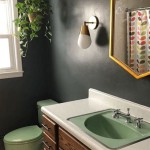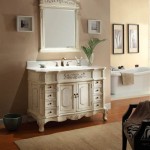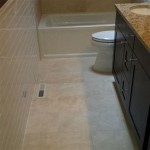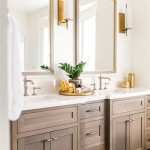Small Bathroom Vanity with Legs: A Stylish and Functional Choice
The small bathroom vanity with legs represents a versatile and increasingly popular choice for optimizing space and enhancing the aesthetic appeal of smaller bathrooms. Unlike traditional cabinet-style vanities that mount directly to the floor, vanities with legs provide an open, airy feel, making the room appear larger and more inviting. This article delves into the various aspects of small bathroom vanities with legs, examining their benefits, materials, styles, and considerations for installation and maintenance.
Benefits of Choosing a Small Bathroom Vanity with Legs
Selecting a small bathroom vanity with legs offers several distinct advantages compared to other types of bathroom vanities. These benefits extend beyond mere aesthetics and contribute to both the functionality and perceived space within the bathroom.
One primary benefit is the illusion of increased space. The open space beneath the vanity allows light to pass through and minimizes the visual bulk typically associated with floor-mounted cabinets. This is especially crucial in smaller bathrooms where every square inch counts. The visibility of the floor beneath the vanity creates a less cluttered environment, contributing to a sense of openness.
Another advantage is the ease of cleaning. Reaching under a vanity to clean the floor can be challenging with traditional designs. With a vanity featuring legs, mopping and sweeping are significantly simplified. This accessibility helps maintain hygiene and reduces the accumulation of dust and debris in hard-to-reach areas. This ease of maintenance can be particularly appealing for individuals with mobility limitations or those seeking to minimize cleaning time.
Furthermore, vanities with legs often provide a more refined and decorative appearance. The exposed legs offer an opportunity to incorporate design details that complement the overall aesthetic of the bathroom. These legs can come in various styles, from sleek and modern to ornate and traditional, allowing for customization to suit individual preferences. This versatility makes it easier to integrate the vanity seamlessly into the existing bathroom design.
Finally, small bathroom vanities with legs can be easier to install and may require less modification to existing plumbing. The open space beneath the vanity can simplify the process of connecting plumbing lines, potentially reducing installation costs and time. This is especially beneficial in older homes where plumbing may not be easily accessible or adaptable.
Materials and Styles of Small Bathroom Vanities with Legs
The construction and design of small bathroom vanities with legs encompass a broad spectrum of materials and styles, each offering unique aesthetic and functional characteristics. Understanding these options is essential for selecting a vanity that aligns with the desired design and budget.
Wood is a common material choice for vanity construction, providing both durability and aesthetic appeal. Solid wood vanities, such as those crafted from oak, maple, or cherry, offer exceptional longevity and a classic, timeless look. However, solid wood can be more susceptible to moisture damage if not properly sealed and maintained. Engineered wood, such as plywood or MDF (Medium-Density Fiberboard), provides a more cost-effective alternative and is often treated to resist moisture. These materials are less prone to warping or cracking in humid bathroom environments.
The legs of the vanity are typically made from wood, metal, or a combination of both. Wooden legs can be carved or turned to create intricate designs, while metal legs offer a more contemporary and industrial aesthetic. Stainless steel and wrought iron are popular choices for metal legs, providing durability and resistance to corrosion. The choice of leg material should complement the overall style of the vanity and the bathroom's design.
Vanity countertops are available in a variety of materials, each with its own advantages and disadvantages. Natural stone countertops, such as granite and marble, offer a luxurious and durable surface. However, they can be more expensive and require regular sealing to prevent staining. Quartz countertops are a popular alternative, providing a similar aesthetic to natural stone with enhanced durability and stain resistance. Laminate countertops are a more budget-friendly option, offering a wide range of colors and patterns. However, they are less resistant to scratches and heat than stone or quartz.
Style considerations for small bathroom vanities with legs range from traditional to contemporary, and everything in between. Traditional vanities often feature ornate details, such as carved legs, raised panel doors, and antique-inspired hardware. These vanities typically incorporate warmer wood tones and classic countertop materials. Contemporary vanities, on the other hand, emphasize clean lines, minimalist designs, and modern materials. These vanities often feature sleek metal legs, frameless cabinets, and integrated sinks.
The choice of style should be guided by the overall aesthetic of the bathroom and the homeowner's personal preferences. It is important to consider how the vanity will integrate with existing fixtures, colors, and design elements.
Installation and Maintenance of Small Bathroom Vanities with Legs
Proper installation and regular maintenance are crucial for ensuring the longevity and optimal performance of a small bathroom vanity with legs. Careful planning and execution during installation, coupled with consistent upkeep, will help preserve the vanity's appearance and functionality.
Before installation, it is essential to take accurate measurements of the available space and ensure that the vanity will fit comfortably. Consider the placement of plumbing lines and electrical outlets, and make any necessary modifications to accommodate the vanity's dimensions. It is also important to check the levelness of the floor and make adjustments as needed to ensure that the vanity sits evenly.
Installation typically involves attaching the vanity to the wall using screws or mounting brackets. It is crucial to use appropriate hardware and techniques to ensure that the vanity is securely fastened and able to support the weight of the countertop and sink. Depending on the complexity of the installation, professional assistance may be required to ensure proper execution and adherence to building codes.
Once the vanity is installed, regular maintenance is essential for preserving its appearance and preventing damage. Regularly wipe down the countertop and cabinet surfaces with a damp cloth to remove dirt and debris. Avoid using abrasive cleaners or harsh chemicals, which can damage the finish. Use a mild soap and water solution for cleaning more stubborn stains.
Periodically inspect the vanity for signs of moisture damage, such as warping, cracking, or discoloration. Address any leaks or water damage promptly to prevent further deterioration. Re-seal the countertop as needed to protect it from stains and water damage. Inspect the legs of the vanity for any signs of rust or corrosion, and apply a protective coating as necessary.
Proper ventilation is also important for preventing moisture buildup in the bathroom. Ensure that the bathroom is adequately ventilated by opening windows or using an exhaust fan during and after showers and baths. This will help reduce humidity levels and minimize the risk of mold and mildew growth.
By following these installation and maintenance guidelines, homeowners can ensure that their small bathroom vanity with legs remains a stylish and functional addition to their bathroom for years to come.
Ultimately, the selection of a small bathroom vanity with legs requires careful consideration of various factors, including space constraints, aesthetic preferences, material durability, and maintenance requirements. By understanding the benefits, styles, and installation considerations outlined above, individuals can make an informed decision and choose a vanity that enhances the functionality and beauty of their small bathroom.

Small Master Bathroom Vanity Free Plans

Diy Bathroom Vanity With Turned Legs Part 1 Addicted 2 Decorating

How To Build A Diy Bathroom Vanity Angela Marie Made

Diy Bathroom Vanity 12 Rehabs Bob Vila

16 Small Bathroom Vanities 24 Inches Under Kelley Nan

Diy Bathroom Vanity For 65 Angela Marie Made

Solid Wood Small Commercial Modern Bathroom Vanities With Legs China Vanity Made In Com

Diy Rustic Bathroom Vanity Sammy On State

The Best 19 Small Bathroom Vanities Of 2024

Bathroom Vanity With Hairpin Legs Pretty Isn T It Rumahkubathroom Unique Diy Small Vanities
Related Posts







